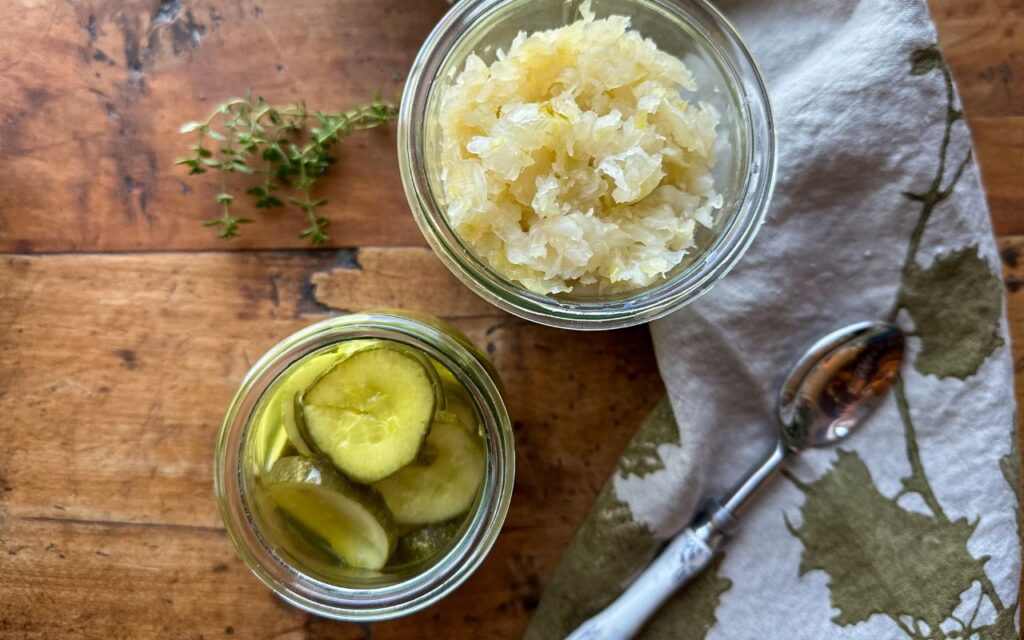What are fermented foods? Are fermented vegetables healthy? Learn more about the world of fermented foods in this science-based guide.
It seems like every time you turn around, you hear that you should be eating more fermented foods, because they are so good for you. But why? How do fermented foods impact your health? And what counts as a fermented food? It might seem like fermented foods, from kombucha to sauerkraut are the latest, greatest foods on the supermarket shelf given the huge buzz these foods receive today, but they’ve actually been around for eons as a means of preserving foods for survival. And now we know that fermented foods have many health benefits.

History of Fermentation
Fermentation has been around since at least 10,000 BCE. Ancient societies, such as the Sumerians and Egyptians, as well as early explorers, used fermentation to preserve food in order to allow people to get enough key nutrients to survive through long winters, when fresh foods couldn’t be harvested, as well as during long travels. Sumerians fermented foods, such as malted barley, bread, and wine. Ancient Egyptians also fermented bread and beer. Explorers like Captain Cook would bring along sauerkraut with them during long voyages to prevent scurvy, a condition related to vitamin C deficiency. And the art of fermentation spread through most cultures and societies. I’ve tasted fermented foods in just about every culture, from Iceland, Greece, Sweden, and Germany to Thailand, Japan, Morocco, and Tanzania. Fermentation was absolutely imperative in order to survive. And as a result, we have some of our favorite foods! Can you imagine cuisine without pickles, wine, bread, and olives?

For a long time, our ancient ancestors didn’t truly understand the fermentation process. It wasn’t until around 1856 that a scientific explanation came along when the French scientist Louis Pasteur documented how this extraordinary process occurs. He learned that particular microorganisms cause different types of fermentations. For instance, a yeast called saccharomyces cerevisiae is responsible for bread rising. The microorganisms lactobacillus bulgaricus and streptococcus thermophilus are involved in yogurt fermentation. And the rest, as they say, is history!

Nutrition in Fermented Foods
Consumption of fermented foods has long been an integral part of the human diet. Living, fermented foods contain at least a thousand times more bacteria than fresh fruits and vegetables. Fermentation results in improved microbial food safety and unique flavors and textures, as each strain is genetically and phenotypically distinct. Fermentations, such as yogurt, wine, kombucha, kimchi, and sauerkraut contain a variety of nutrients, in addition to microbes, with health benefits. Fermentation increases vitamin and bioactive compound content; in fact, it helps produce vitamins from microbes (including GABA, CLA, folic acid, vitamin B12, riboflavin, and thiamin), which are rich in fermented foods. That’s why fermented foods positively affect our health, particularly in the realm of gastrointestinal health.

When we eat fermented foods, we consume microbes that help diversify our gut microbiome. Numerous studies have looked at the connections between the gut microbiome and the body; there are links between a robust, healthy gut microbiota profile and many conditions, including reduced obesity, type 2 diabetes, digestive conditions, inflammatory disease, and cognitive decline. For example, a decreased risk of Alzheimer’s is associated with a diverse gut microbiome in mice studies.
To diversify the gut microbiome, we can eat foods containing fiber, such as fruits, vegetables, pulses, and whole grains. We can also increase our intake of fermented probiotic foods, such as kimchi, yogurt, and sauerkraut. Keep in mind that not all of these foods contain live, active cultures. And not all fermented foods are probiotics as they have encountered processing steps that deactivates the cultures, such as baking and canning. Even live fermented foods may not be defined as probiotics, because the strain present in the food must have clinically proven benefits. But fermented foods can still be healthy, delicious additions to your diet!

Fermented Foods
There are lots of fermented foods available in many traditional diets. Some commonly known ones are kimchi, yogurt, sauerkraut, pickles, wine, beer, soy sauce, and bread. There are two processes to create fermented foods: wild fermentation and culture fermentation.
Wild fermentations occur naturally. Naturally-occurring bacteria in the air are necessary for wild fermentations to occur. Consider sauerkraut, which doesn’t require a starter culture. However, sourdough bread requires a culture and a back-slopping technique. Back-slopping happens when you add part of the old culture to the new culture.
Beneath these two main categories, fermented foods can fall into three subcategories: alcoholic fermentation, lactate fermentation, and acetic acid fermentation. Wine is a commonly consumed alcohol fermentation. Kimchi is an example of lactate fermentation, and vinegar is an example of acetic acid fermentation. Kombucha is an example of all three types.

What is kombucha? Kombucha is a type of fermentation, which has been investigated through in vitro (performed in a test tube, culture dish, or elsewhere outside a living organism) and in vivo (performed or taking place in a living organism) studies. Kombucha contains polyphenols, which occur naturally in plants and are boosted during digestion. A diet high in polyphenols correlates with decreased risks for high blood pressure, cardiovascular disease, inflammation, and type 2 diabetes. Polyphenols also contain anticancer properties because they work as antioxidants by reducing the free radicals in our bodies.

What Happens During Fermentation?
Fermentation occurs because of the presence of microorganisms, which are small units of life that the naked eye can’t see. Bacteria and yeast are examples of the types of microorganisms that are required for fermentation to take place. Fermentation happens in the absence of oxygen. The process happens when a microorganism turns sugar into alcohol or lactic acid. For example, when yeast fermentation occurs, glucose gets converted to two pyruvate molecules, then converts to two molecules while releasing carbon dioxide. The released carbon dioxide gets trapped in the gluten network, which causes bread to rise. The final byproduct is two molecules of ethanol. Bacterial fermentation’s final byproduct is lactic acid. First, glucose converts to two pyruvate molecules; then, pyruvate converts to lactic acid with the help of lactate dehydrogenase enzyme. Yogurt, tempeh, and soy sauce are all fermented through this process.
There are a few basic practical steps in the fermentation process, with the first being to choose from and collect a large variety of raw materials, such as cabbage, pickles, and olives. After these materials are collected, they must be prepared through a variety of methods, such as chopping, grinding, mixing, salting, slicing, submerging, or compacting. Commercial producers of food then incubate it and measure the temperature, oxygen, and length of time. Some products, such as bread, have fermentation terminated. Typical microbes are used, such as lactic acid bacteria. Fermentation has a low pH of 4 – 4.5.

There are different microbes in food that give them a certain flavor and texture. For example, yeast and molds have fungi in them, and beer, wine, and bread have saccharomyces. Plants have pichia, soy sauce contains aspergillus, tempeh has mucoraceae, and surface brie contains penicillium. The nutrients in foods encourage growth of the microbe, and the structure of the material determines the texture.
The end result is the characteristic flavors we love in fermented foods, such as that complex taste in a deep red wine, the mildly caramel-sour flavor of baked sourdough bread, and the briny quality of olives.
How To Fit Fermented Foods into Your Healthy Diet
Despite their known benefits, food models worldwide don’t make specific recommendations for fitting in fermented foods. For instance, MyPlate has recommendations for fruits, vegetables, dairy, protein, and grains categories, with no mention of fermented foods. However, many traditional diet patterns include fermented foods. For instance, Japanese cultures consume fermented foods frequently and have one of the longest life spans out of any nation in the world, so why is there hesitation to provide recommendations for fermented foods?
One of the reasons governments and health organizations don’t make official recommendations for eating more fermented foods may be out of a concern for food safety. Properly produced fermented foods can have many health benefits, as we’ve learned; however, fermented food made incorrectly can cause sickness due to growth of harmful bacteria.
How to find plant-based fermented foods? Look for live, active cultures in fermented foods stored in refrigerated cases. Many canned products like pickled beets, sauerkraut, and dill pickles are processed in vinegar; thus, are not fermented.
List of Plant-Based Fermented Foods that Are Commonly Available
Do enjoy a variety of fermented foods, whether they contain live active cultures or produced through the art of fermentation, in your healthy plant-based diet.
Try a few of my favorite recipes that call upon fermented foods:
References
- Bell, V., Ferrão, J., & Fernandes, T. (2017). Nutritional Guidelines and Fermented Food Frameworks. Foods, 6(8). https://doi.org/10.3390/foods6080065. https://www.ncbi.nlm.nih.gov/pmc/articles/PMC5575640/
- Tuba Esatbeyoglu, Secil Sarikaya Aydin, Büsra Gültekin Subasi, Ezgi Erskine, Recep Gök, Salam A. Ibrahim, Birsen Yilmaz, Fatih Özogul & Esra Capanoglu (2023) Additional advances related to the health benefits associated with kombucha consumption, Critical Reviews in Food Science and Nutrition, DOI: 10.1080/10408398.2022.2163373. https://www.tandfonline.com/doi/abs/10.1080/10408398.2022.2163373
- Kitwetcharoen, H., Phung, L. T., Klanrit, P., Thanonkeo, S., Tippayawat, P., Yamada, M., & Thanonkeo, P. (2023). Kombucha Healthy Drink—Recent Advances in Production, Chemical Composition and Health Benefits. Fermentation, 9(1), 48. https://doi.org/10.3390/fermentation9010048. https://www.mdpi.com/2311-5637/9/1/48
- National Institute of Health (2023, June 12). Beyond the brain: The gut microbiome and Alzheimer’s disease. National Institute on Aging. Retrieved September 21, 2023, from https://www.nia.nih.gov/news/beyond-brain-gut-microbiome-and-alzheimers-disease#:~:t ext=These%20different%20types%20of%20bacteria,chemicals%20that%20affect%20bra in%20function.
As an Amazon Influencer, I earn from qualifying purchases. For more information about affiliate links, click here.
More Tools for Eating and Living the Goodness

